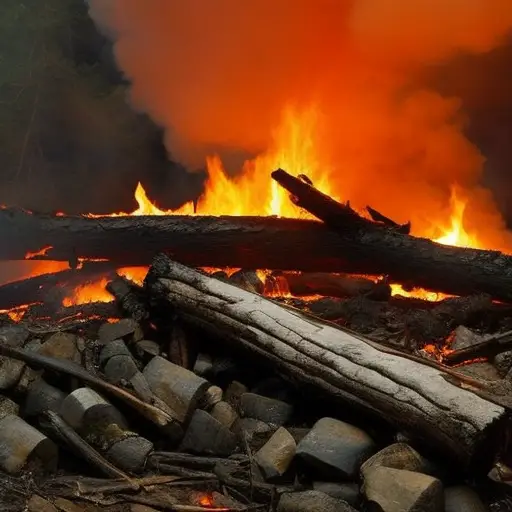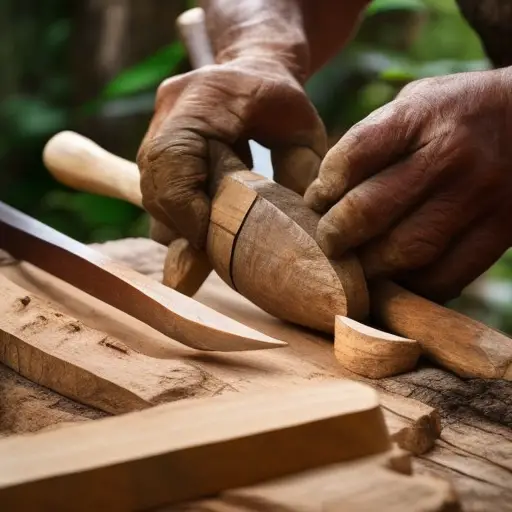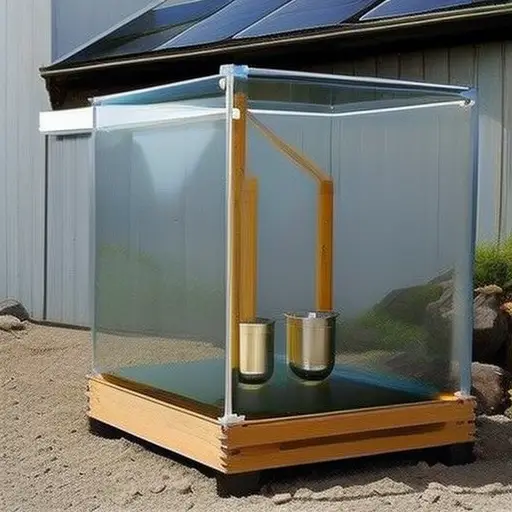Techniques for Starting a Fire in Damp Conditions

In the face of damp conditions, the challenge of starting a fire can be likened to navigating a stormy sea. However, with the right techniques at hand, one can conquer the elements and ignite a flame.
This article explores practical strategies for kindling a fire in unfavorable weather conditions. From selecting appropriate firewood to maintaining proper airflow, these insights will equip readers with the knowledge to triumph over the dampness and embrace the warmth of a well-lit fire.
Choose the Right Firewood
To ensure success in starting a fire in damp conditions, it is crucial to carefully select the appropriate firewood. The type of firewood you choose can significantly impact your ability to ignite a fire and keep it burning. When selecting firewood for damp conditions, it is essential to prioritize dry wood that has been properly seasoned. Dry wood has a lower moisture content, making it easier to ignite and maintain a consistent flame. Hardwoods, such as oak or maple, are ideal choices as they burn longer and produce more heat compared to softwoods like pine or cedar.
In addition to selecting the right type of firewood, proper storage is also essential. Firewood should be stored in a dry, well-ventilated area to prevent moisture absorption. Stacking the firewood off the ground, using a rack or pallet, can help promote air circulation and prevent contact with damp soil. Covering the woodpile with a tarp or waterproof cover can provide an extra layer of protection against rain or snow.
Gather Dry Kindling
When starting a fire in damp conditions, it is essential to have alternative fire-starting methods readily available. Gathering dry kindling is crucial for ensuring a successful fire ignition.
Additionally, proper preparation, such as collecting enough dry kindling in advance, can significantly improve the chances of starting a fire in damp conditions. Utilizing natural windbreaks can also help protect the fire from moisture and increase its chances of catching.
Alternative Fire-Starting Methods
Gathering dry kindling is an essential step in employing alternative fire-starting methods in damp conditions. When traditional fire starting tools like matches or lighters may fail, it becomes crucial to explore DIY fire starters.
Here are three effective alternatives to consider:
-
Cotton balls soaked in petroleum jelly: Coat cotton balls with petroleum jelly and store them in a waterproof container. These highly flammable DIY fire starters provide a long-lasting burn, making them ideal for igniting damp kindling.
-
Dryer lint: Collect lint from your dryer’s lint trap and pack it into small bundles. This lightweight material catches fire easily and can be used to ignite larger pieces of kindling.
-
Char cloth: Made by charring 100% cotton fabric in a metal container, char cloth catches sparks and creates an ember. It can easily be blown into a flame and used to ignite damp kindling.
Importance of Proper Preparation
Having explored alternative fire-starting methods, it is imperative to emphasize the importance of proper preparation by gathering dry kindling in order to increase the likelihood of successfully starting a fire in damp conditions.
Proper preparation techniques play a crucial role in ensuring the success of starting a fire. One of the key aspects of preparation is gathering dry materials, especially kindling. Dry kindling is essential as it ignites quickly and generates sufficient heat to ignite larger fuel sources.
To gather dry kindling, it is recommended to look for dead branches or twigs that are sheltered from moisture, such as under tree canopies or fallen logs. Additionally, one can also gather dry leaves or use a knife to scrape off the damp outer layers of wood.
Utilizing Natural Windbreaks
To maximize your chances of successfully starting a fire in damp conditions, it is essential to utilize natural windbreaks to gather dry kindling. Natural windbreaks offer several benefits, including shielding your fire from strong gusts and providing a barrier against moisture.
When searching for natural shelter options, keep the following in mind:
- Look for dense vegetation: Trees with thick foliage and low-hanging branches can act as effective windbreaks and provide ample dry kindling.
- Seek out rock formations: Large rocks or cliffs can create a natural barrier against wind, protecting your fire and preserving dry kindling nearby.
- Utilize natural depressions: Hollows in the landscape, such as dips in the ground or small valleys, can offer shelter from the wind and help gather dry kindling due to accumulated debris.
Utilize Fire Starters or Accelerants
One effective method for starting a fire in damp conditions is by utilizing fire starters or accelerants. When faced with wet firewood or a damp environment, fire starters can provide the necessary heat and ignition source to get a fire going. There are several fire starter alternatives that can be used in these situations.
One popular option is using cotton balls soaked in petroleum jelly. These can be easily ignited and provide a sustained flame to ignite the firewood. Another alternative is using commercial fire starter sticks or squares, which are designed to ignite quickly and burn for a longer period of time.
However, it is important to exercise caution when using fire starters or accelerants. Safety precautions should always be followed to prevent accidents or injuries. Firstly, it is essential to read and follow the manufacturer’s instructions for the specific fire starter being used. This will ensure proper usage and minimize any potential risks.
Additionally, fire starters should be stored in a cool, dry place away from flammable materials. When igniting the fire, it is advisable to keep a safe distance and avoid directly inhaling the fumes. Furthermore, fire starters should never be used in enclosed spaces or indoors, as this can lead to carbon monoxide poisoning or fires.
Build a Proper Fire Structure
When it comes to building a fire in damp conditions, it is crucial to choose the right materials and utilize fire accelerants effectively. The proper fire structure will allow for better air circulation and help the fire burn more efficiently.
Choosing the Right Materials
In order to build a proper fire structure in damp conditions, it is essential to carefully select the appropriate materials. The right materials can significantly improve fire ignition and ensure a successful fire in challenging conditions.
Here are three key items to consider when choosing materials for building a fire in damp conditions:
-
Dry kindling: Use dry twigs, bark, or small branches as kindling. Look for materials that are not wet or damp, as they will more easily catch fire and generate heat to ignite larger fuel sources.
-
Firestarter: Utilize reliable firestarters like waterproof matches, lighters, or firestarter sticks. These will provide a consistent source of ignition, even in damp conditions.
-
Natural tinder: Opt for natural tinder such as dry grass, leaves, or pine needles. These materials are highly flammable and can help in starting a fire quickly.
Utilizing Fire Accelerants
To build a proper fire structure in damp conditions, it is crucial to utilize fire accelerants that can effectively aid in the ignition process. Fire accelerants are substances that can be added to the fire to make it burn hotter and faster, helping to overcome the challenges of dampness.
One commonly used fire accelerant is lighter fluid, which can be applied to the firewood or kindling to enhance the combustion process. Other firestarter alternatives include commercial fire starters, such as fire gel or fire cubes, which are designed to ignite easily and produce a sustained flame. These accelerants can significantly improve the chances of starting a fire in damp conditions, ensuring a reliable source of warmth and comfort. However, it is important to use fire accelerants responsibly and follow proper safety precautions.
Transitioning into the subsequent section about ‘protecting the fire from moisture’, it is essential to take measures to shield the fire from any moisture that may extinguish it.
Protect the Fire From Moisture
One effective method for safeguarding a fire from moisture is by utilizing waterproof barriers. These protective coverings act as a shield, preventing water or dampness from extinguishing the flames.
Here are three items that can be used as waterproof barriers to protect the fire:
-
Tarpaulin: A tarpaulin is a versatile and durable material that can effectively shield the fire from moisture. It is lightweight, easy to carry, and can be set up quickly to create a protective covering over the fire.
-
Fire-resistant blanket: A fire-resistant blanket is specifically designed to withstand high temperatures and repel water. It can be placed over the fire to protect it from rain or other sources of moisture.
-
Waterproof container: A waterproof container can be used to keep the firewood dry before use. By storing the firewood in a sealed, waterproof container, you can ensure that it remains dry and ready to use, even in damp conditions.
Maintain Proper Airflow
Proper airflow is essential for maintaining a fire in damp conditions. When faced with wet or damp firewood, maximizing ventilation becomes crucial to ensure a steady and consistent flame. Without adequate airflow, the fire may struggle to ignite or may smolder and produce excessive smoke.
To create air circulation, start by arranging the firewood in a way that allows for gaps between the logs. This will promote the flow of oxygen, which is necessary for combustion. Additionally, using smaller kindling and tinder materials will help in creating a well-ventilated fire. These smaller pieces catch fire more quickly and easily, generating the necessary heat to dry out the surrounding wood.
Another effective technique to maintain proper airflow is to use a fire pit or a fire ring. These structures provide a contained space for the fire, preventing it from being suffocated by surrounding dampness. Additionally, they often come with features such as adjustable vents or grates that can be used to regulate air intake and maximize ventilation.
Remember to keep an eye on the fire and adjust the logs as needed to ensure a steady supply of oxygen. By prioritizing proper airflow, you can overcome damp conditions and enjoy a roaring fire.
Frequently Asked Questions
How Can I Effectively Protect the Fire From Moisture?
To effectively protect a fire from moisture and prevent firewood dampness, it is important to employ proper techniques and tools. This ensures the fire remains dry and can continue burning efficiently in damp conditions.
What Are Some Commonly Used Fire Starters or Accelerants?
Fire starter options and alternative accelerants are commonly used to ignite fires in various conditions, including damp environments. These materials provide a reliable source of ignition, enabling efficient fire starting in challenging circumstances.
Are There Any Specific Techniques to Maintain Proper Airflow for a Fire in Damp Conditions?
What are the techniques for starting a fire in damp conditions? Proper airflow is crucial to maintaining a fire in such conditions. It ensures efficient combustion and prevents the fire from being extinguished by dampness.
How Can I Choose the Right Firewood for Starting a Fire in Damp Conditions?
When choosing firewood for starting a fire in damp conditions, it is important to select wood that is dry and well-seasoned. Proper firewood storage can help ensure that the wood remains dry and ready for use.
What Are Some Key Tips for Building a Proper Fire Structure in Damp Conditions?
Building a fire pit and using proper kindling are key tips for starting a fire in damp conditions. The fire pit provides a dry and controlled environment, while kindling helps ignite the fire more easily.
Conclusion
In conclusion, by following these techniques for starting a fire in damp conditions – such as choosing the right firewood, gathering dry kindling, utilizing fire starters or accelerants, building a proper fire structure, protecting the fire from moisture, and maintaining proper airflow – individuals can overcome the challenges posed by damp conditions and successfully start a fire.
By implementing these strategies, one can ensure a reliable source of warmth and comfort even in unfavorable weather conditions.





